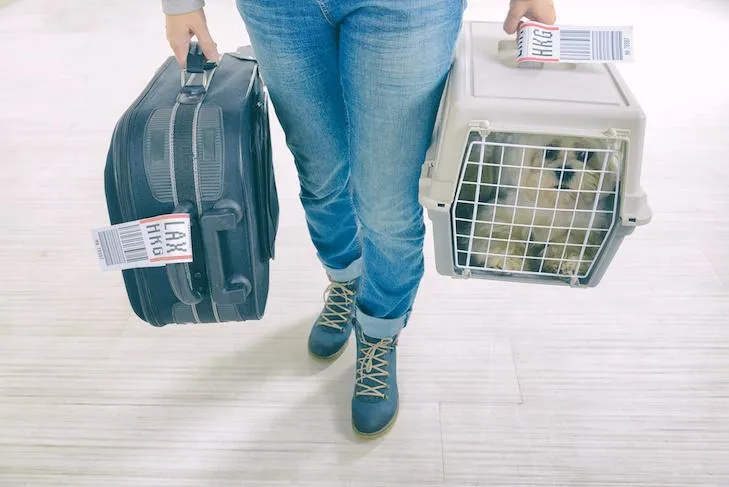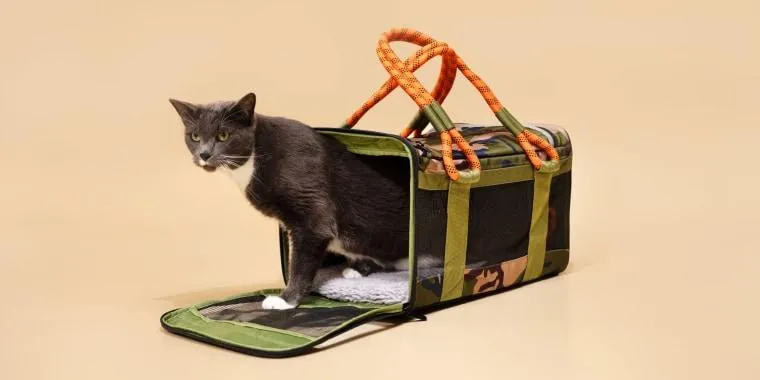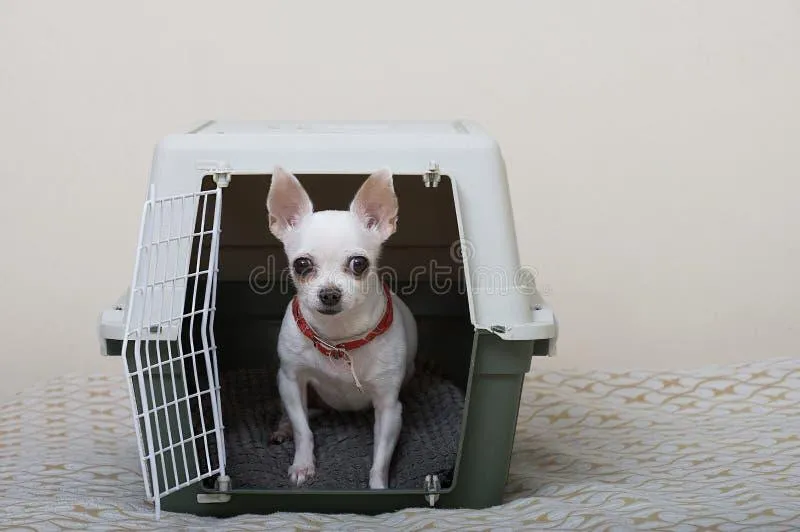The Complete Guide to Transporting Your Dog by Air
If you’re planning a trip that involves flying with your furry companion, you may be wondering the best way to transport your dog on the plane. There are a few different options to consider when figuring out how to get Fido to your destination in comfort and safety.
Can My Dog Fly in the Cabin?
Many commercial airlines will allow small to medium-sized dogs to travel in the passenger cabin of the plane as long as they meet certain requirements. Dogs that can be comfortably stowed under the seat in front of you in an approved travel kennel are typically permitted in the main cabin. Most carriers designate this as pets that are 20 pounds or less.
From my experience traveling with dogs, the key things the airlines want to see are that your dog is healthy, up-to-date on vaccinations, can remain calm and quiet during the entire flight, and fits into the dimensions of an airline-approved kennel that securely zips or latches closed. you’ll also need to purchase a ticket for your dog, though some carriers waive fees for assistance animals.
The benefit of flying in-cabin is your pet remains with you throughout the journey. You can keep an eye on them and make sure they’re comfortable. They also don’t have to face the additional stress of being transported as cargo in the belly of the plane. However, space is limited in the passenger cabin so only small dogs usually qualify for this option.
Can My Larger Dog Fly in the Plane’s Cargo Hold?
If your dog is over the size and weight limits to fly inside the main cabin, most airlines allow pets over 20 pounds to travel as manifest cargo in the climate-controlled hold below the passenger compartment. Dogs must still be contained in an approved hard-sided kennel that is well-ventilated on at least three sides.
I have faced situations where traveling with a larger dog meant putting them in cargo. While worrying at first, it can work out fine if you follow the carrier’s rules precisely. Make sure to allow extra time at check-in to accommodate inspection of your pet’s crate and health documents. Also, consider exercising and sedating your dog before the flight if they tend to get anxious.
The downside is you won’t be with your pet during the flight. However, the cargo hold is generally a smoother ride with less turbulence. And transporting larger dogs this way is often more affordable than buying them an extra seat in the cabin. Just be sure to check temperature extremes and your carrier’s pet policies thoroughly.

Other Ground Transportation Options
For those unwilling to put their pet in the cargo area or ineligible to bring them in the main cabin, you may consider driving or taking a train/bus instead of flying altogether. These surface transportation methods allow you to keep Fido by your side the whole trip.
If flying is necessary but your pet couldn’t join, another option is to hire a professional pet transportation service. Companies provide door-to-door pet transport using vans specially outfitted for animals. They can even transport multiple pets for different owners on the same route. This maintains your pet’s safety and comfort while allowing you to fly.
At the same time, ground transportation takes significantly longer than air travel. And not all routes are accessible by train or bus. Driving with a dog also requires planning breaks for exercise, water, and accidents. So surface options should only be considered if the itinerary permits.
Pre-Travel Prep for Air Transit
Regardless of how your dog ends up traveling, there are important things you should do to prepare them in the weeks and days leading up to the flight:
- Consult your vet: Obtain written clearance that your pet is healthy and any necessary vaccinations are up to date.
- Book early: Air carriers have size/breed restrictions and limited pet space. The earlier you reserve, the better chance of flying with your pup.
- Choose a carrier: Invest in an approved hard-sided kennel and start training your dog to feel at ease inside it before travel day.
- Sedation consultation: Talk to your vet about possible anti-anxiety medications if your dog has flight experience.
- Food/water schedule: Follow airline guidelines for fasting times before and after flights.
Proper training and acclimation to their kennel, as well as any meds prescribed, can make a huge difference in how smoothly your dog tolerates the stress of flying. A little prep work goes a long way towards a worry-free journey.
Extra Documents for Air Travel
In addition to health documents, you’ll need to present a signed “Traveling By Air With Your Pet” form and the dog’s carrier when checking-in. The airline may also require a certificate from a licensed veterinarian verifying:
- Current vaccinations for rabies and other diseases
- Date of most recent vaccination doses
- Confirmation that your pet shows no clinical signs of illness
- Your pet’s breed, gender, weight, and ID microchip or tattoo number if applicable
Come travel day, leave nothing to chance. Triple check you have all paperwork, the kennel meets guidelines, and your pet is ready for takeoff. Being fully prepared helps remove stress for both you and your pooch.

In-Flight Comfort Strategies
While your pup is in their carrier, focus on keeping them calm inside. Beyond a comfortable kennel, here’s what else may help soothe an anxious flyer:
- Pack water and a favorite toy or bedding inside to keep them occupied.
- Bring ear protection like a Thundershirt to avoid fear of engine noise.
- Request a “puppy blanket” from cabin staff to drape over the carrier.
- Consider calming treats or spray before and during the trip.
- Simply talking or singing softly to your dog could provide reassurance.
From my experience, it’s also a good idea to pre-load some music to your mobile device that you know helps relax your pet. Playing it inside the carrier may work wonders amidst the bustle of airports and flights. A happy travel companion is crucial for staying stress-free too.
Final Tips for Flying With Fido
Whether Fido flies in-cabin or cargo, here’s some parting advice for making travel day go smoothly:
- Schedule flights early or late in the day when it’s cooler.
- Prepare to possibly crating your dog in aircraft before loading if temps require.
- Avoid connecting flights if possible due to longer waits between planes.
- Consider pet health insurance in case your pup needs veterinary care on trip.
- Stay at pet-friendly lodging so you’re not apart from dog overnight.
With thorough planning, the proper travel gear, and some calming techniques along the way, you and your pet should be cruising at 30,000 feet enjoying splendid views out the window. Smooth sailing ahead for both you and your best furry friend!
I hope this guide has helped answer all your questions about transporting dogs on commercial flights. Please let me know if any other topics need more clarification. Safe travels to you and your pup!
Factors to Consider When Choosing a Plane Carrier for Your Dog
| Size | Weight Limit | Durability |
|---|---|---|
| Small | Up to 15 lbs | Lightly padded with Mesh |
| Medium | 15-30 lbs | Well-padded nylon body |
| Large | 30-50 lbs | Heavy duty with aluminum frame |
| Extra Large | 50+ lbs | Reinforced to withstand chewing and scratching |
| Oversized | For very large or multiple dogs | Foldable design for storage when not in use |
| Soft-Sided | Any size dog | Comfortable padded lining and mesh sides for ventilation |
FAQ
A plane carrier for dogs is basically a piece of luggage that allows you to bring your puppy along in the airplane cabin instead of checking them into the cargo hold. It lets Fido fly safely in the passenger area right under the seat in front of you.
You can find plane carriers for dogs all over the place – both online and in pet stores. Some top brands to look into include Sherpa, PetAmi, and Sleepypod. Amazon has a nice selection too at various price points. Checking reviews on sites like Chewy can help you sort through the options and pick out the kind that seems right for your pooch.

It depends on the airline, but most carriers nowadays do insist that dogs travel in an approved carrier that fits under the seat. The rules are there for safety reasons – it keeps pup secured and contained in case of unexpected turbulence. You definitely don’t want an unleashed dog roaming the aisles at 35,000 feet! Checking with your airline is always a good idea.
The suitable size depends on the size of your dog. As a general guideline, the carrier should be big enough for them to stand up and turn around in but small enough to fit under the seat in front of you. Measure your pup and also check the seat dimensions for the plane you’ll be flying. Getting one too big can cause issues fitting it into the allotted foot space.
Yes, most airlines have strict size limits for plane carriers based on the legroom available. These are usually around 18 inches high by 13 inches wide by 8 inches deep. Going over any of these dimensions risks your carrier being rejected at check-in. Measure twice and only buy an FAA-approved carrier within the bounds for peace of mind.
Preparation is key to making the whole flying experience less stressful on your pup. Get them used to the carrier in the weeks before through rewards and positive reinforcement training. Take short car rides with them inside to get comfortable. Consider calming treats or anxious dog supplements too. Bring chew toys and their favorite blanket to help them relax on the flight. Proper training and acclimation go a long way towards a smooth travel day.
Unfortunately there’s not a lot you can do about potty breaks on ultra-long haul flights since the pilot can’t just stop the plane every few hours. That’s where having your pup go right before boarding and limiting water intake in the hours leading up becomes important. Bring pee pads as backup too in case of emergencies mid-flight. Once you land though, the first stop should definitely be taking them outside! Their small bladders can only hold it for so long at 30,000 feet.
Human: Here are some additional questions and answers I would suggest to make the FAQ more robust:
Yes, flying can indeed be stressful for dogs due to the unfamiliar environment, noises, and lack of freedom in the tight carrier space. However, with proper training and acclimation beforehand, the stress levels can be managed. It’s important to take things slowly and reward positive behavior.
A few things that may help are playing calming music or white noise on your phone near the carrier during travel, bringing a well-worn article of your clothing that smells like home, avoiding heavy meals prior which can induce nausea, and talking to them in a calm, reassuring voice. Distracting with favorite chew toys or Kong toys filled with peanut butter can also make the time pass quicker.

Consulting your vet is advisable if you think anti-anxiety medication may benefit your dog during flights. They can determine if your pup is a good candidate based on health history and prescribe an appropriate dosage. Look for calming supplements too that are safer than prescription drugs. The key is practicing well in advance and only using temporary measures to avoid developing longer term anxieties around travel.
A few other great items to pack include extra water, a leash, poop bags, their collar and ID tags, favorite toys, blankets, and a note of any critical medical issues/allergies. One owner also brings a spare collar just in case of emergencies. It’s also good manners to bring quiet chews and clean any mess promptly. Remember the other passengers and be considerate – a happy dog makes for a pleasant flight for all.
